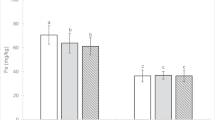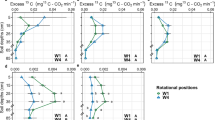Summary
The effects of winter waterlogging and a subsequent drought on the growth of winter barley and winter wheat have been examined. We used lysimeters containing soil monoliths with facilities to control the water table and a mobile shelter to control rainfall. Winter wheat was grown on a clay and on a sandy loam, but winter barley only on the clay soil. Lysimeters were either freely-drained during the winter or waterlogged with the water table 10 cm below the soil surface from 2 December until 31 March (that could occur by rainfall with a return period of 2 to 3 years). The lysimeters then were either irrigated so that the soil moisture deficit did not exceed 84 mm, or subjected to drought by limiting rainfall (equivalent to a 1 in 10 dry year in the driest area of England) so that the deficits reached maximum values of 150 mm in the clay and 159 mm in the sandy loam by harvest.
Winter waterlogging restricted tillering and restricted the number of ears for all crops; grain yield of the winter barley was decreased by 219 g/m2 (30%), and that of winter wheat by 170 g/m2 (24%) and 153 g/m2 (21% on the clay and sandy loam respectively.
The drought treatment reduced the straw weight of winter barley by 75 g/m2 (12%) but did not significantly depress the grain yield. For winter wheat on the clay, where the soil was freely-drained during the winter, drought depressed total shoot weight by 344 g/m2 (17%) and grain weight by 137 g/m2 (17%), but after winter waterlogging, drought did not further depress total or grain weight. In contrast, the winter wheat on the sandy loam was not significantly affected by drought.
From these results, which are discussed in relation to other experiments in the United Kingdom, it seems that winter waterlogging is likely to cause more variation in the yield of winter barley and winter wheat than drought.
Similar content being viewed by others
References
Belford R K 1979 Collection and evaluation of large monoliths for soil and crop studies. J. Soil. Sci. 30, 363–373.
Belford R K 1981 Response of winter wheat to prolonged waterlogging under outdoor conditions. J. Agric. Sci., Camb. 97, 557–568.
Bingham J 1966 Varietal response in wheat to water supply in the field, and male sterility caused by a period of drought in a glasshouse experiment. Ann. Appl. Biol. 57, 365–377.
Blackwell P S and Wells E A 1983 Limiting, oxygen flux densities for oat root extension. Plant and Soil 73, 129–139.
Cannell R Q, Davies D B, Mackney D and Pidgeon J D 1978 The suitability of soils for sequential direct drilling of combine-harvested crops in Britain: a provisional classification. Outlook Agric. 9, 306–316.
Cannell R Q, Belford R K, Gales K and Dennis C W 1980 A lysimeter system used to study the effect of transient waterlogging on crop growth and yield. J. Sci. Food Agric. 31, 105–116.
Cannell R Q, Belford R K, Gales K, Dennis C W and Drew RD 1980 Effects of waterlogging at different stages of development on the growth and yield of winter wheat. J. Sci. Food Agric. 31, 117–132.
Cannell R Q, Belford R K and Thomson R J 1981 Effects of single and multiple waterloggings on the growth and yield of winter wheat on a clay soil. Agric. Res. Coun. Letcombe Laboratory Annu. Rep. 1980, 34–35.
Cannell R Q and Belford R K 1982 Crop growth after transient waterlogging.In Advances in Drainage, Proc. 4th Nat. Drainage Symp., Am. Soc. Agric. Eng., St. Joseph, Michigan. pp 163–170.
Cannell R Q, Belford R K, Blackwell P S, Govi G and Thomson R J 1982 Effects of waterlogging on soil aeration, root and shoot growth, and yield of winter oats. Agric. Res. Coun. Letcombe Lab. Annu. Rep. 1981, 39–40.
Colbourn P and Dowdell R J 1984 Denitrification in field soils. Plant and Soil 76, 213–225.
Dennis C W 1983 Probability of waterlogging estimated from historical rainfall records. Agric. Water Management 6 397–401.
Dowdell R J, Crees R, Burford J R and Cannell R Q 1979 Oxygen concentrations in a clay soil after ploughing or direct drilling. J. Soil. Sci. 30, 239–245.
Ellis F B, Christian D G, Bragg P L, Henderson F K, Prew R D and Cannell R Q 1984 A study of mole-drainage with simplified cultivation for autumn-sown crops on a clay soil. 3. Agronomy, root and shoot growth of winter wheat, 1978–80. J. Agric. Sci., Camb. 102 (In press).
French B K and Legg B J 1979 Rothamsted irrigation 1964–76. J. Agric. Sci., Camb. 92, 15–37.
Gales K and Wilson N J 1981 Effects of water shortage on the yield of winter wheat. Ann. Appl. Biol. 99 323–334.
Gales K 1983a. Yield variation of wheat and barley in Britain in relation to crop growth and soil conditions—A review. J. Sci. Food Agric. 34, 1085–1104.
Gales K 1983b A survey of irrigation experiments with winter wheat. Agric. Res. Coun. Letcombe Lab. Annu. Rep. 1982, 27–28.
Gales K, Ayling S M and Cannell R Q 1984 Effects of waterlogging and drought on winter wheat and winter barley grown on a clay and a sandy loam soil: II Soil and plant water relationships. Plant and Soil 80, 67–78.
Hall D G M, Reeve M J, Thomasson A J, and Wright V F 1977 Water retention, porosity and density of field soils. Soil Survey Tech. Monog. No. 9, Harpenden, England.
Hall K C 1979 A gas chromatographic method for the determination of oxygen dissolved in water using an electron capture detector. J. Chromat. Sci. 16, 311–313.
Jones H G 1979 Effects of weather on spring barley yields in Britain. J. Nat. Inst. Agric. Bot. 15, 24–33.
Murray R 1977 The 1975/76 drought over the U.K.-Hydrometeorological aspects. Met. Mag. 106, 129–145.
Russell E W 1973 Soil Conditions and Plant Growth Longman, London.
Smith L P 1976 The Agricultural climate of England and Wales. Tech. Bull. No. 35 Min. Agric., Fish. Food, London.
Smith L P and Trafford B D 1976 Climate and drainage. Tech. Bull No. 34, Min. Agric., Fish. Food, London.
Van't Woudt B D and Hagan R M 1957 Crop responses at excessively high soil moisture levels.In Drainage of Agricultural Lands. Ed. J N Luthin. pp 514–578. Am. Soc. Agron., Madison, Wisconsin.
Watson D J 1963 Climate, weather, and plant yield.In Environmental Control of Plant Growth, Ed. L T Evans, pp 337–350. Academic Press, New York and London.
Zadoks J C, Chang T T and Konzak C F 1974 A decimal code for the growth stages of cereals. Weed Res. 14, 415–421.
Author information
Authors and Affiliations
Rights and permissions
About this article
Cite this article
Cannell, R.Q., Belford, R.K., Gales, K. et al. Effects of waterlogging and drought on winter wheat and winter barley grown on a clay and a sandy loam soil. Plant Soil 80, 53–66 (1984). https://doi.org/10.1007/BF02232939
Received:
Revised:
Issue Date:
DOI: https://doi.org/10.1007/BF02232939




